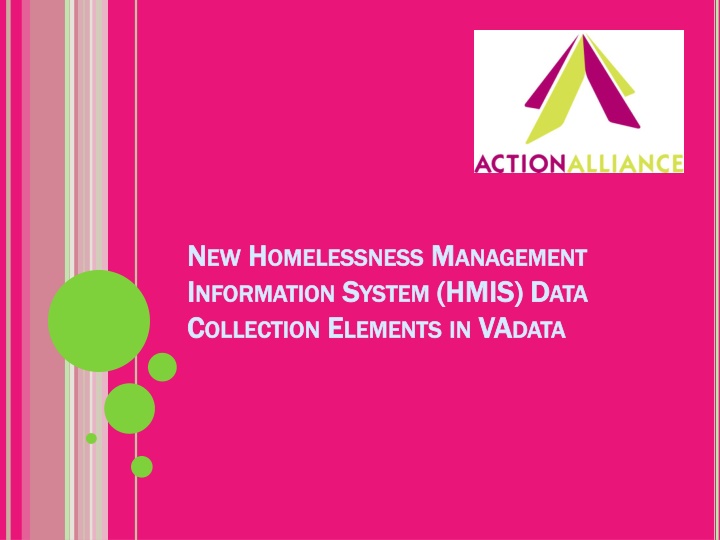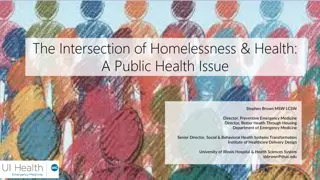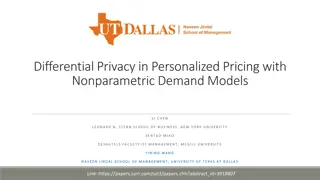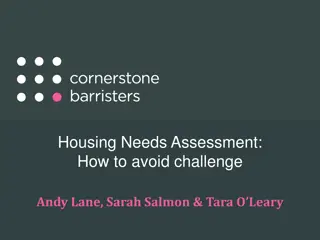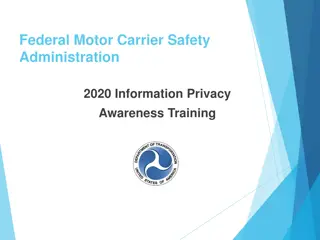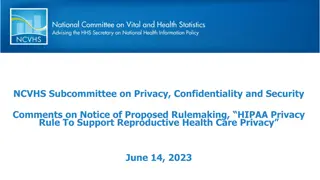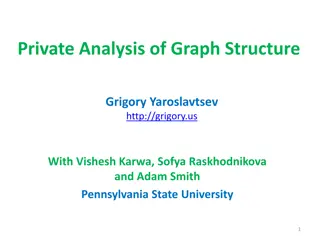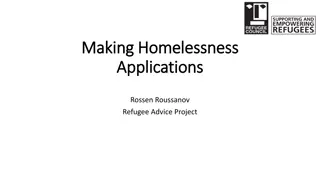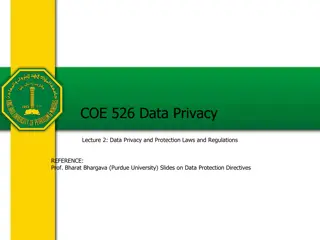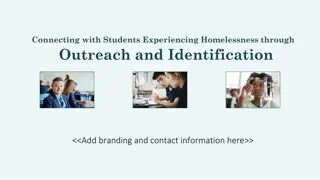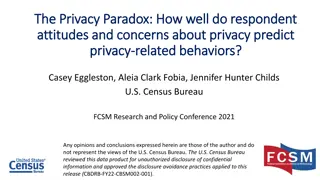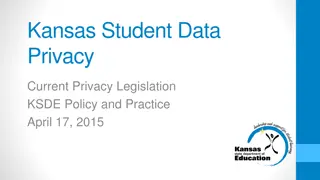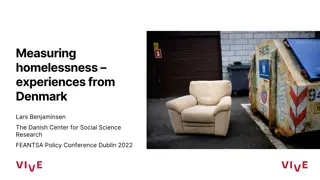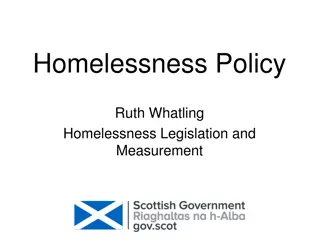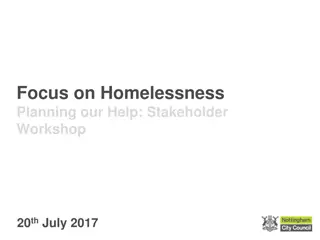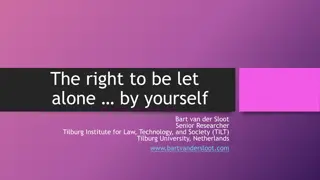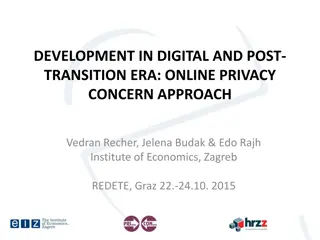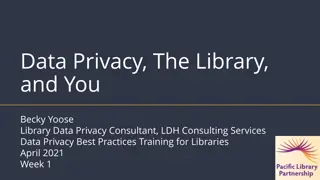Data Collection and Privacy Concerns in Homelessness Management Information System
The Housing Stabilization tab within the HMIS has seen new data elements added to enhance Advocacy forms for domestic violence agencies. The need to balance data collection with survivor privacy, complying with strict provisions like VAWA and FVPSA, is paramount. Understanding survivor empowerment and the risks associated with the data requested by HUD is crucial in ensuring quality services while protecting vulnerable populations.
Download Presentation

Please find below an Image/Link to download the presentation.
The content on the website is provided AS IS for your information and personal use only. It may not be sold, licensed, or shared on other websites without obtaining consent from the author.If you encounter any issues during the download, it is possible that the publisher has removed the file from their server.
You are allowed to download the files provided on this website for personal or commercial use, subject to the condition that they are used lawfully. All files are the property of their respective owners.
The content on the website is provided AS IS for your information and personal use only. It may not be sold, licensed, or shared on other websites without obtaining consent from the author.
E N D
Presentation Transcript
N NEW EW H HOMELESSNESS OMELESSNESS M MANAGEMENT I INFORMATION NFORMATION S SYSTEM YSTEM (HMIS) D C COLLECTION OLLECTION E ELEMENTS LEMENTS IN ANAGEMENT (HMIS) DATA IN VA VADATA DATA ATA
HOUSING STABILIZATION TAB: In January 2015, new data elements were added to the Advocacy form so that local Sexual and Domestic Violence Agencies (SDVAs) had the capacity to collect data for their DHCD, HUD (federal grant), and Emergency Solutions grant programs. In 2018, those data elements were expanded to include the required fields to make VAdata an HMIS comparable database. This means that several new fields have been added to the Housing Stabilization tab within the Advocacy form, and there are new concerns around the protection of survivor data.
DATA COLLECTION & SURVIVOR PRIVACY Due to the sensitive nature of the data requested by HUD, agencies will need to be particularly vigilant about the what is entered into the system, as well as the data being reported to CoCs. Agencies should carefully consider what and how much information is actually needed to provide quality services, and if that information could be used to harm a survivor if it was ever discovered.
DATA COLLECTION & SURVIVOR PRIVACY Survivor privacy extends beyond following the laws and protecting information. As advocates, we are also concerned with survivor empowerment for trauma-informed services. Data collection should be less focused on "what is allowed" and primarily focused on "what does the survivor want to share," giving the individual the power, choice, and control over their information.
WHATSTHE BIG DEAL ABOUT PII? 87% 87% of the population in the United States is identifiable based on 5-digit zip, gender, and date of birth. 53% 53% is identifiable by city/town, gender, and date of birth. 18% 18% is identifiable by county, gender, and date of birth. Reference: Simple Demographics Often Identify People Uniquely by Latanya Sweeney
VAWA & FVPSA PROVISIONS VAWA (The Violence Against Women Act) and FVPSA FVPSA (Family Violence Prevention and Services Act) have very strict provisions about the nature of the information that can be collected about and reported on survivors of sexual and domestic violence. VAWA
FVPSA RULE From the Family Violence Prevention and Services Program Rule: https://www.federalregister.gov/docu ments/2016/11/02/2016-26063/family- violence-prevention-and-services- programs#p-307
Because HMIS data in particular is kept indefinitely, it is not possible to obtain time limited consent, as required by FVPSA. Thus no FVPSA funded program should enter no FVPSA funded program should enter data directly into shared HMIS databases data directly into shared HMIS databases. . Housing information entered into VAdata is 100% encrypted from anyone outside of the agency. Information should only be shared in the aggregate informed, written, and reasonably-timed written consent should be obtained before sharing this data in any other format for any reason for any reason. This consent also cannot cannot be a mandatory statute for receiving services. aggregate, and
WHATCANBE SHARED WITHOUTA RELEASE? Aggregate data (totals) General data trends Hypothetical cases Discussing general cases together - OK Discussing specifics that would identify individual cases, families, or people NOT OKAY OKAY OK NOT
WITH WHOM CAN THIS INFORMATION BE SHARED? There s a difference between who should be considered insiders and outsiders Insiders Insiders Staff within the agency who work or interact directly with the survivor. Only the information that is imperative or vital should be shared.
Theres a difference in who should be considered insiders and outsiders Outsiders Outsiders EVERYONE ELSE This includes law enforcement, child welfare workers, other VSPs or service programs, funders, auditors, allies , vendors, etc. If a survivor hasn t explicitly (in writing) granted permission to release their data to outsiders, don t share it.
U USING SINGAND D DATA ATA E ELEMENTS LEMENTS AND A ACCESSING CCESSING HMIS HMIS
WHATS NEW? ENCRYPTION KEYS What is an encryption key? Each agency will have its own encryption key that will grant access to the HMIS data under the agency s account. Only your agency will (and should) hold the Only your agency will (and should) hold the encryption key for your data. encryption key for your data. You will only need to create your key ONCE, and one key should be used for your entire agency. DO NOT LOSE YOUR ENCRYPTION KEY DO NOT LOSE YOUR ENCRYPTION KEY
WHATDOESAN ENCRYPTION KEY LOOK LIKE? Here s an example of an encryption key: arzbZlmkW6vW0H3WZE4Uw/jYJymuC0B2IKSCz/er0S3CX73Wf3j9YZDKz43JWFe3 qAxJVMwElSSVCOgVYj5s3kPucDUCk3LCCc2gN/7OAgPcU1ZwEV0S5VtROFx5gi/Gp qFpECBkr/1zv2uhqDabZBWD2cBRB8bYXl08gi6dqBI2slO6ZkG/FDGwZZgQsyWiIjit MydFK6nHNZxLIEKexrU+1/HwRuGss1W5HU0UFjbkZfrGYHl2jfxLxNdC1kIZKE/Bmx GrJx486d9DqhH4zyiv8VKclkj7a201VgCEiuVHh3hIOGhAWJkDJ26pZBfLA1SIzkf9Lyt SztR3cIaOl84uZQuuBIeXkFb95Yp75j7kEed0EB3hl862Zu3sCWSF5JZ2TsgXf41esB yYT+f5b6Q6Z28hwN/hp+2AGrl9tKtHpI/ZTnK008H9HHXX/e6olwyK0RVORyufkVNv k2tlVAdI25eVHTIyd09bQCb8lwCSYxtEL4YZ1RVEd+EXD3JSmve+TOwSfMqBR6HEFA oS0b5dTtSjt3m6zhtNRH8IT0dZ4ARS0wKrGZS9qJBlEAwuu5KnXL9rrdi0hX+U4/70 DPxLsdlK24WZLc9lS6Ra5XdygKzkmvzerqb0lk4OF9tadbg0L3myYBWCyesxOVJFKQ IDAQABAoICAQCUK5s4aG2ptAUk80yA8EaQBEDGmjrZojSx/6jJ5/8n2l74NBQpSr38 NGlftVbh5UgG3niRa7JHEgYrs+BmxGrJx486d9DqhH4zyiv8VKclkj7a201VgCEiuVHh 3hIOGhAWJkDJ26pZBfLA1SIzkf9LytSztR3cIaOl84uZQuuBIeXkFb95Yp75j7kEed0E B3hl862Zu3sCWSF5JZ2TsgXf41esByYT+f5b6Q6Z28hwN/hp+2AGrl9tKtHpI/ZTnK 008H9HHXX/e6olwyK0RVORyufkVNvk2tlVAdI25eVHTIyd09bQCb8lwCSYxtEL4YZ1R VEd+EXD3JSmv1/HwRuGss1W5HU0UFjbkZfrGYHl2jfxLxNdC1kIZKE/BmxGrJx486d 9DqhH4zyiv8VKclkj7a201VgCEiuVHh3hIOGhAWJkDJ26pZBfLA1SIzkf9LytSztR3cIa Ol84uZQuuBIeXkFb95Yp75j7kEed0EB3hl862Zu3sCWSF5JZ2TsgXf41esByYT =----- END PRIVATE KEY-----
L LOGGING OGGINGIN INWITH WITH Y YOUR OUR K KEY EY
HELP! THISISCONFUSING! This is new for ALL of us. Please This is new for ALL of us. Please don t hesitate to contact us if you don t hesitate to contact us if you have questions or concerns. have questions or concerns.
H HELP ELP O OPTIONS PTIONS You may see this symbol by several fields You may see this symbol by several fields on the form: on the form: Click on the symbol for more detailed Click on the symbol for more detailed information or requirements of the information or requirements of the field. field.
HELP! VADATASNOTWORKING. If you think something is wrong with VAdata, please let us know! Give us a call at 804.377.0335 804.377.0335 or email us at vadataadmin@vsdvalliance.org vadataadmin@vsdvalliance.org We don t use VAdata every day in the same ways you do, so sometimes the only way that we know something is broken is when you tell us. We also like to talk with you by phone when you have questions because we may need additional details about your concern in order to fix the issue.
HOW CAN I GET ADDITIONAL HELP ABOUT OTHER TOPICSOR CONCERNS? The Action Alliance staff urge you to contact us whenever you have a question or a concern about VAdata, resources, advocacy, policy, training, funding, or anything else. Staff can be reached at 804.377.0335 804.377.0335 Or you can visit our website to send a message directly to staff members. Visit https://vsdvalliance.org/contact/.
